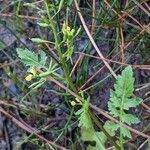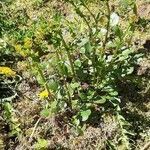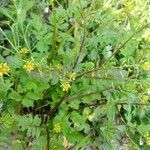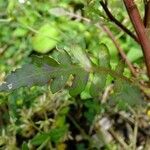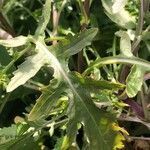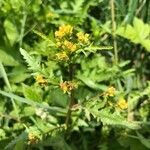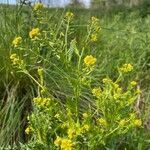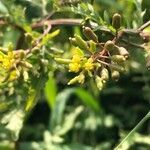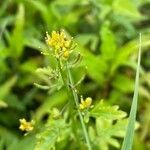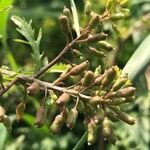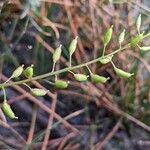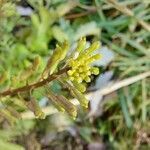Herbs annual or rarely short-lived perennial, (5-)10-100(-140) cm tall, glabrous, rarely hirsute. Stems erect, simple or often branched above, ribbed. Basal leaves rosulate, withered early; leaf blade lyrate-pinnatisect, (4-)6-20(-30) × 1-5(-8) cm. Cauline leaves petiolate or subsessile, auriculate or amplexicaul, lyrate-pinnatisect, (1.5-)2.5-8(-12) × (0.5-)0.8-2.5(-3) cm; lateral lobes oblong or ovate, smaller than terminal lobe, (1 or)2-6(or 7) on each side of midvein, sometimes absent, margin subentire or irregularly dentate, sinuate, serrate, or crenate. Racemes ebracteate. Fruiting pedicels divaricate or slightly to strongly reflexed, (2.5-)3-8(-12) mm, slender, straight or curved. Sepals oblong, 1.5-2.4(-2.6) × 0.5-0.8 mm. Petals yellow or pale yellow, spatulate, (1.5-)1.8-2.6(-3) × 0.5-1.3(-1.5) mm. Filaments 1-2.5 mm; anthers ovate, 0.3-0.5 mm. Ovules 20-90 per ovary. Fruit oblong, ellipsoid, or oblong-ovoid, often slightly curved, (2.5-)4-10(-14) × (1.5-)1.7-3(-3.5) mm; valves not veined; style 0.2-1(-1.2) mm. Seeds brown to yellowish brown, ovoid or subglobose, colliculate, biseriate, 0.5-0.9 × 0.4-0.6 mm. Fl. and fr. Mar-Oct. 2n = 32.
Annual or shortlived perennial herb with taproot, glabrous, 10-110 cm high. Stems erect, solitary or a few together, unbranched or branched in upper parts. Basal leaves lyrate-pinnatisect, usually evanescent; cauline leaves few to numerous, 2.5-12 by 0.7-3 cm, lyrato-pinnatisect with 2-6 pairs of lanceolate lateral lobes, shortly to indistinctly petiolate, auriculate; terminal lobe ⅓ to ½ of total leaf length; margin irregularly serrate-crenate. Racemes ebracteate, terminal, often branched, and from upper leaf axils, in flower much condensed with numerous flowers, in fruit up to 50 cm long and rather dense; pedicels somewhat curved, patent to deflexed, 3.5-7 mm long. Sepals oblong, 1.6-2.4 mm long. Petals pale yellow, spathulate, 1.6-2.6 mm long. Anthers 0.3-0.6 mm long. Ovary cylindrical with distinct style and not or slightly expanded stigma. Siliquae sausage-like, often curved, 5-12 by 1.7-3 mm; valves rather firm; style 0.4-1 by c. 0.3 mm with not or slightly broader stigma. Seeds brown to light brown, spheroid, 0.6-0.9 mm, finely collicu-late.
Perennial, rarely annual, taprooted herb. Stems erect, rarely decumbent, glabrous or hairy, (3)-20-40-(100) cm tall. Lvs glabrous or hairy; margins toothed. Rosette lvs petiolate, auriculate at base, deeply pinnatifid to pinnate, (2)-4-7-(10) × 1-3 cm. Stem lvs similar to rosette lvs, auriculate at base, becoming smaller with narrower lobes above, the uppermost sometimes simple. Pedicels glabrous or sparsely hispid, erecto-patent at flowering, spreading at fruiting, (2)-4-7 mm long. Sepals 1.5-2-(2.5) mm long. Petals yellow, = sepals. Silicle glabrous, oblong to elliptic, curved, (2)-4-7 × 2-3 mm; valves not veined; style 0.5-1 mm long. Seeds pale brown, c. 0.8 mm long, finely colliculate, in 2 rows per locule.
Annual or biennial 10–60 cm tall, rarely taller, erect; stems often red-pigmented, glabrous. Leaves deeply lyrate-pinnatifid; 2–12 cm long; lobes irregularly serrate; base auriculate; terminal lobe narrow, obtuse to acuminate. Sepals 1.5 mm long. Petals 1–2 mm long, yellow. Stamens 6. Style 0.5–1 mm long. Siliqua inflated, curved, contracted abruptly into style, mostly 8–9 mm long, rarely shorter, 2–3 mm wide; valves nerveless; pedicels spreading to horizontal, 4–10 mm long. Seeds elliptic, 0.6–0.9 mm long, in 2 rows; testa finely colliculate, not mucous.
Taprooted annual or biennial, erect, to 1 m, the taller pls commonly much-branched; lvs lanceolate to oblong-obovate, at least the lower pinnatifid; pet 1.5–2.5 mm, about equaling the sep, mature pedicels widely spreading, 3–7 mm; frs 2.5–9 mm, to twice as long as the pedicels; middle cauline lvs generally distinctly winged toward the base and auriculate, so that the lf appears ± sessile; 2n=32. (R. islandica, misapplied) R. palustris is circumboreal, with 3 vars. in our range.
A cabbage family herb. It is a small cress plant. It can grow from seed each year or or take 2 years to complete its life cycle. It is a herb up to 1 m high. The leaves are crinkled and have deep lobes. The flowers are yellow. The pods are short and less than 1 cm.
